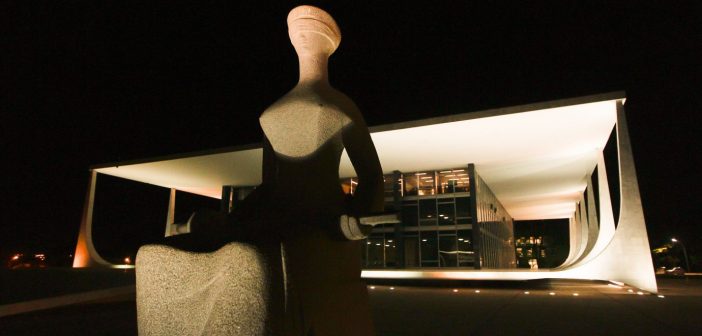Pilot Project – Format
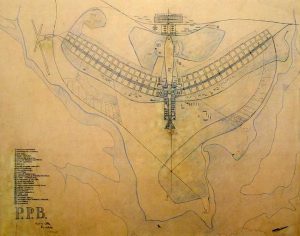
The Pilot Plan for Brasília, in Brazil’s Federal District, was drawn up by Lúcio Costa, whose plan won the 1957 urban planning public contest to design Brazil’s soon-to-be new capital city. Initially, its shape was thought to be based upon that of a cross; it is also commonly compared to an aeroplane. However, there are those, including the late Costa himself, that consider it more similar in shape to a butterfly, rejecting earlier comparisons
National Congress – Some meanings for its distinctive shape
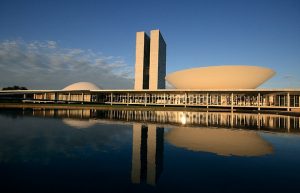 The National Congress is one of Brasília’s most famous icons. The seat of legislative power, Congress is made up of the Federal Senate and the Chamber of Deputies. Well known for its two domes, one pointing downwards (Senate) and the other pointing upwards (Chamber), if one takes a close look at its 100-metre-high towers, the letter ‘H’ is easily discernible. For the building’s designers, the letter is meant to be a subtle symbol for their concerns regarding a triplet of words which in the Portuguese language all start with ‘H’; Man (Homem), Honour (Honra) and Honesty (Honestidade). Another curiosity is that the sun rises right in the middle of the ‘H’, as does, at some times of the year, the moon.
The National Congress is one of Brasília’s most famous icons. The seat of legislative power, Congress is made up of the Federal Senate and the Chamber of Deputies. Well known for its two domes, one pointing downwards (Senate) and the other pointing upwards (Chamber), if one takes a close look at its 100-metre-high towers, the letter ‘H’ is easily discernible. For the building’s designers, the letter is meant to be a subtle symbol for their concerns regarding a triplet of words which in the Portuguese language all start with ‘H’; Man (Homem), Honour (Honra) and Honesty (Honestidade). Another curiosity is that the sun rises right in the middle of the ‘H’, as does, at some times of the year, the moon.
The City Park – Considered to be one of the world’s biggest urban parks
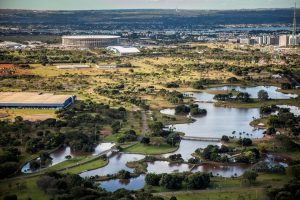 The Dona Sarah Kubitschek City Park is the world’s biggest urban leisure park, with 420 hectares, making it 100 hectares bigger than New York’s Central Park. It was designed by the Landscape Gardener Burle Marx and founded on 11 October 1978. Boasting plenty of attractions, particularly of the sporting variety, such as volleyball & basketball courts, football pitches, a kart track, a skate park and a horse riding area, as well as restaurants, a fairground and a space for cultural events, entry to the park, which also features an artificial lake and a 6.5-mile walking track, is free of charge.
The Dona Sarah Kubitschek City Park is the world’s biggest urban leisure park, with 420 hectares, making it 100 hectares bigger than New York’s Central Park. It was designed by the Landscape Gardener Burle Marx and founded on 11 October 1978. Boasting plenty of attractions, particularly of the sporting variety, such as volleyball & basketball courts, football pitches, a kart track, a skate park and a horse riding area, as well as restaurants, a fairground and a space for cultural events, entry to the park, which also features an artificial lake and a 6.5-mile walking track, is free of charge.
Caves – There are 82 listed caves in Brasília
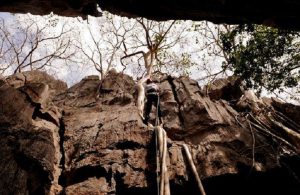 The Federal District’s cave system is one of the region’s natural treasures. Some are near and some are far from the city, but their stunning views are little-known and little-visited by the local community. So far, 82 caves have been indexed in and around the capital. The majority of them are located in the east and north of the Federal District, a region of predominantly limestone and dolomite rock formations. Despite its potential for tourism, not many people are aware of its richness and, in the main, those who venture out into the hinterlands are speleologists and climbers.
The Federal District’s cave system is one of the region’s natural treasures. Some are near and some are far from the city, but their stunning views are little-known and little-visited by the local community. So far, 82 caves have been indexed in and around the capital. The majority of them are located in the east and north of the Federal District, a region of predominantly limestone and dolomite rock formations. Despite its potential for tourism, not many people are aware of its richness and, in the main, those who venture out into the hinterlands are speleologists and climbers.
The rocks have the daunting appearance to be expected after being sculpted by thousands of years of wind and water erosion. Irregular and pointed, they make life difficult for anyone trying to reach the depths of the chasms. It goes without saying that any visit needs to be made with a professional guide and adequate clothing and equipment.
The Brazilian Flag at ‘Três Poderes Square’ – The largest hoisted flag in the world
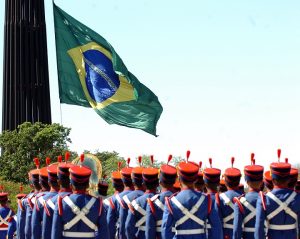 According to the Guinness Book of Records, the flag measures 286m2 and is the largest raised flag anywhere in the world. It is larger than most of the apartments projected by Lúcio Costa’s Pilot Plan. The flag’s substitution, often made necessary due to its being torn by the wind, is done during special ceremonies on the first Sunday of the month, on national holidays, on each of the Armed Forces days, and also on the first day of new Federal legislatures. According to the ceremony, the new flag must reach the top of the mast before the old one may start to be lowered. The three branches of the Armed Forces, along with the Federal District’s Public Security Forces, alternate duties for each new flag-raising ceremony. The flags are provided by the Federal Regions, the Armed Forces and other public and private entities.
According to the Guinness Book of Records, the flag measures 286m2 and is the largest raised flag anywhere in the world. It is larger than most of the apartments projected by Lúcio Costa’s Pilot Plan. The flag’s substitution, often made necessary due to its being torn by the wind, is done during special ceremonies on the first Sunday of the month, on national holidays, on each of the Armed Forces days, and also on the first day of new Federal legislatures. According to the ceremony, the new flag must reach the top of the mast before the old one may start to be lowered. The three branches of the Armed Forces, along with the Federal District’s Public Security Forces, alternate duties for each new flag-raising ceremony. The flags are provided by the Federal Regions, the Armed Forces and other public and private entities.
The flagpole is a tubular conic structure, consisting of 24 100-metre-high tubes, which are arranged around circular central sections, which in turn close toward the cone’s vertex, culminating in one single large-calibre tube, which supports the flag. The number of tubes represents that of the Federal Regions (States) at the time the mast was built, the beginning of the 1970s. Apart from the need for the national flag’s presence to be an imposing one, the flagpole’s height is also due to the need for the flag to fly higher than any of the other represented powers; seeing as the central building of the National Congress is the highest of the plaza, the mast needed to be even higher.
For more information about Brazil, travelling to Brazil, Holidays in Brazil and Brazilian tourism please also visit VBRATA Visit Brazil Travel Association.
The Brazilian Destinations online training courses for travel agents are offered and managed exclusively by VBRATA Visit Brazil Travel Association. Brazil Online Training by VBRATA offers travel industry specialists the opportunity to learn more about Brazilian destinations and travel products by offering a selection of Brazilian online courses so that travel agents can increase their knowledge and become a specialist in Brazil.
















